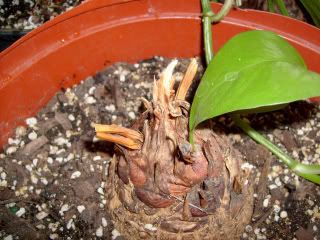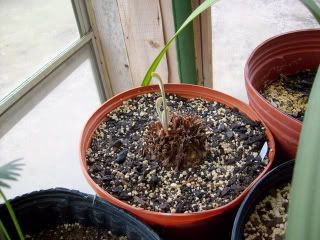Page 1 of 3
A nice start for this season,
Posted: Sun Feb 17, 2008 9:32 pm
by Knnn
Posted: Mon Feb 18, 2008 4:35 am
by Kansas
AHHHH yes! Now you see why this is my favorite Cycad??? TOUGH AS NAILS!!
Posted: Mon Feb 18, 2008 7:03 am
by Dean W.
What's the minumum temp for Zamia floridana?
Dean
Posted: Mon Feb 18, 2008 9:22 am
by Knnn
Dean, Z.floridana is accepted as 8B, (15F - 20F), The wide leaf "Palatka Giant" form is reported to be even more cold tolerant. Have some I'm trying to establish in ground here, ( a little building with heat over them

Wes, I checked the roots on that one about 1 1/2 months ago, ( just to make sure there was no decay ), it had just about regrown all that was lost!
Found one with "rippled" leaves

( The leaflets on all the fronds so far are showing this, will get a better photo soon)

Steve
Posted: Mon Feb 18, 2008 10:00 am
by Dean W.
Good to know hopefully mine has a chance in the ground then. I'm in zone 8b.

Dean
Posted: Mon Feb 18, 2008 11:04 am
by Kansas
So do you just need to keep the roots dry for a while or no?
Also, UMMMMM, I have seen KNNN's Palatka Giant that he states he is "Trying" to establish, Yea, don't let him be so modest. He DOES have them established. He has them looking GREAT for being in a Zone 5.
With his method of protection on those, and mine with my Revoluta, I am hopeing to be able to prove that cycads CAN be grown in zone 5 with a little bit of "want to" and "elbow grease".
Posted: Mon Feb 18, 2008 11:14 am
by Knnn
I'll consider the Zamias established when they start setting seed

Wes, Is your Sago still hanging in there? If yours does ok, I might try one.
Steve
Posted: Mon Feb 18, 2008 1:17 pm
by Dean W.
LOL!!! When they start setting seeds!

Posted: Mon Feb 18, 2008 1:44 pm
by Kansas
Knnn wrote:I'll consider the Zamias established when they start setting seed

Wes, Is your Sago still hanging in there? If yours does ok, I might try one.
Steve
Well the leaves are brown down to about 3" from the Caudex. At that point, they are still green so I suspect that it is doing fine. I gave it NO supplemental heat, jus thte sun coming the plexyglass.
Posted: Mon Feb 18, 2008 3:17 pm
by lucky1
ooooh, those rippled leaves are cool, Steve!
Is the ripple on the floridana leaf? or the Giant?
The leaf form will be interesting to watch.
Barb
Posted: Mon Feb 18, 2008 4:47 pm
by Knnn
Hi Barb,
The leaf belong to Cycas sp. "Wilailak", becoming one of my favorites too

Steve
Posted: Mon Feb 18, 2008 6:04 pm
by Kansas
That wilailik leaf has happened on mine too. And also, thats the only cycad I have had that was like that. Weird huh?
Posted: Mon Feb 18, 2008 7:58 pm
by lucky1
Wonderful if there's going to be a new cycad, whose leaves are all wavy.
Can we hope for that?
Barb
Wilailak wavy leaves
Posted: Fri Feb 22, 2008 9:41 pm
by chumleycycads.com
No Barb, Wilailak often do this. But it's not permanent. I have hundreds of them (thanks to Jody) and at any one time
there are several Wilailaks doing the wavy leaf thing. Also , the caudex will crack and look deformed and will swell to a larger size
and then not throw as many leaves as you might expect for that size caudex. (and grow generally slow). I think this is indicative
of Thailand cycads in general though.
Posted: Sat Feb 23, 2008 6:59 am
by Knnn
Bob,
Thank you for the info, I guess I will enjoy it while it last

There has been some talk lately that the smaller leaf Z.floridanas might be more cold tolerant than the wider leaf versions?
Have you noted any differences ?
Steve
Zamia Floridana
Posted: Sat Feb 23, 2008 2:27 pm
by chumleycycads.com
Well Steve , the narrow leaf zamia from the West coast doesn't grow as far North as the East coast wide leaf zamia,
as far as the wild populations are located geograpically (by a significant number of miles). And also, you spoke as if it were a smaller zamia (in size), but of course it is not, only having leaves that are more narrow. In fact, I have noted down through the years, that the narrow leafed zamia produces more individual leaves in a flush than the wider leaf plants. Also, it has more recurve
than the wider variety.The West coast narrow leaf zamia grows most often in a marly soil with a lot of oyster shell, where as the East coast wide leaf variety grow in mostly sandy soil of the Alantic ocean as the tubers grow very deep. But Steve, don't forget , there are four other varieties of zamia in other locations around the state that actually are different in little subtle ways also. As
far as one in particular being "more cold tolerent", I can't really say for sure. I personally think they are all about the same. Bob
Posted: Sat Feb 23, 2008 3:58 pm
by Knnn
Bob,
I appreciate you taking the time to explain that, also the cultural info!
( The only ones I've ever seen in person are the ones in my green house, so my knowledge is somewhat limited

Steve
Posted: Sat Feb 23, 2008 7:41 pm
by Kansas
Mr. Chumnley, I just spoke to the wife and the other couple that we are going with in July and all seem to be OK with me (us) visiting you around that time. Can't wait to meet you!
Posted: Sat Feb 23, 2008 8:02 pm
by virtualpalm
Knnn wrote:There has been some talk lately that the smaller leaf Z.floridanas might be more cold tolerant than the wider leaf versions?
Have you noted any differences ?
Steve, I have personally visited over 30 populations of coontie throughout Florida. I have not grown plants from all of these populations, and living in Miami does not, of course, provide me with much first-hand experience with respect to cold hardiness. But my guess would be that the plants that grow the furthest north would be most likely to have the best tolerance of cold temperatures. The northernmost population of coontie that I am aware of occurs in Fort Clinch State Park just outside Jacksonville, FL. The plants there have leaflets of intermediate width and are quite attractive (see photo below).
Hope this helps.
Jody

Palatka Giant
Posted: Sat Feb 23, 2008 8:18 pm
by virtualpalm
Speaking of coontie, I thought you all might like to see a photo of a decent-sized Palatka Giant plant (they do get larger than this!) in someone's yard near Palatka, FL.
Jody

Posted: Sun Feb 24, 2008 6:24 am
by Knnn
Jody,
That does help, and thanks for the photos!
There seems to be a native population listed in S.E. Georgia, I would imagine these are similar to what is found near Jacksonville, FL. ?
http://plants.usda.gov/java/county?stat ... mbol=ZAPUP
So far, the ones outside here seem to be holding their own, ( in a small structure), I'm keeping my fingers crossed

Steve
Posted: Sun Feb 24, 2008 6:50 am
by virtualpalm
Knnn wrote:There seems to be a native population listed in S.E. Georgia
I also found that reference when I was preparing my Florida coontie "expedition" a few years ago. I spent months trying to track down the locality of those plants. I even contacted the head biologist for all the state parks in Georgia, as well as a local biologist at the Crooked River State Park in SE Georgia (located within a few miles of the Fort Clinch State Park on the Florida side)... all to no avail. Those guys had never seen a coontie anywhere in Georgia, and they had both been biologists with the state for decades. I don't know if the "Georgia coontie" is a myth, if there used to be populations there that are now gone, or if there still are small, isolated populations in that state. If anyone has any reputable information on this, I would greatly appreciate receiving it.
Jody
Posted: Sun Feb 24, 2008 6:54 am
by Kansas
I know a guy that is growing them in the ground in KANSAS!!

Steve, keep up the good work. I myself would like to try this come Mid March, but I dont have any that I can experiment with. I don't want to try it with seedlings as I think a sappling would be better and I don't have any of that size

Every day that goes by is one step closer to warmer temps and my Revoluta is still holding on in the enclosure. But I would LOVE to try a Palatka Giant in the ground this Spring.
Posted: Sun Feb 24, 2008 4:56 pm
by Knnn
Still moving along,
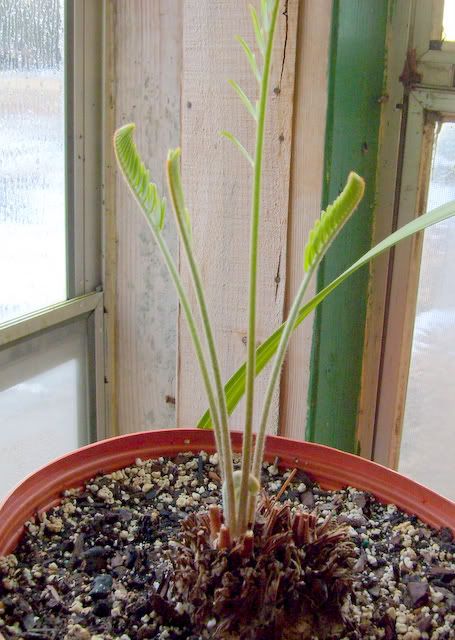
With the green house lows in the 50*'s, I'm surprised to see growth so early in the season.
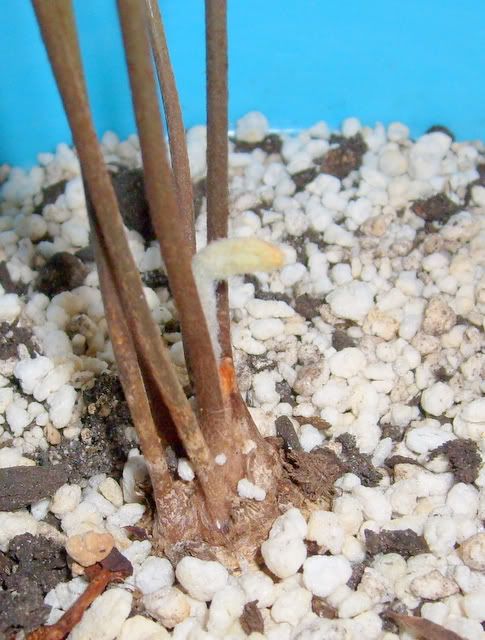
This one is starting to do something, ( hoping to see a cone

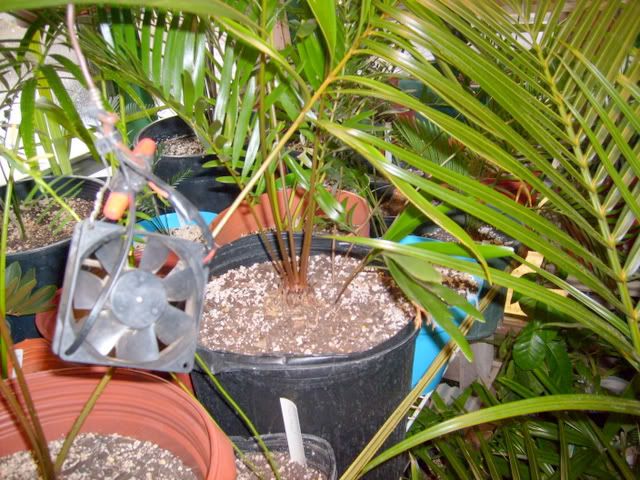
Steve
Posted: Sun Feb 24, 2008 5:28 pm
by Kansas
GREAT job Steve. I don't have any Cycads starting to flush except my large Taitungensis which I THOUGHT might be dead. Here is the HORRIBLE thing about it thou. It had a BIG starter leaf, I took it out to take a pic, and when I moved it back, my fat, dumb, idiotic, blubbering a$$, elbow hit the leaf breaking it off along with the tip of another. So now I am left with this...
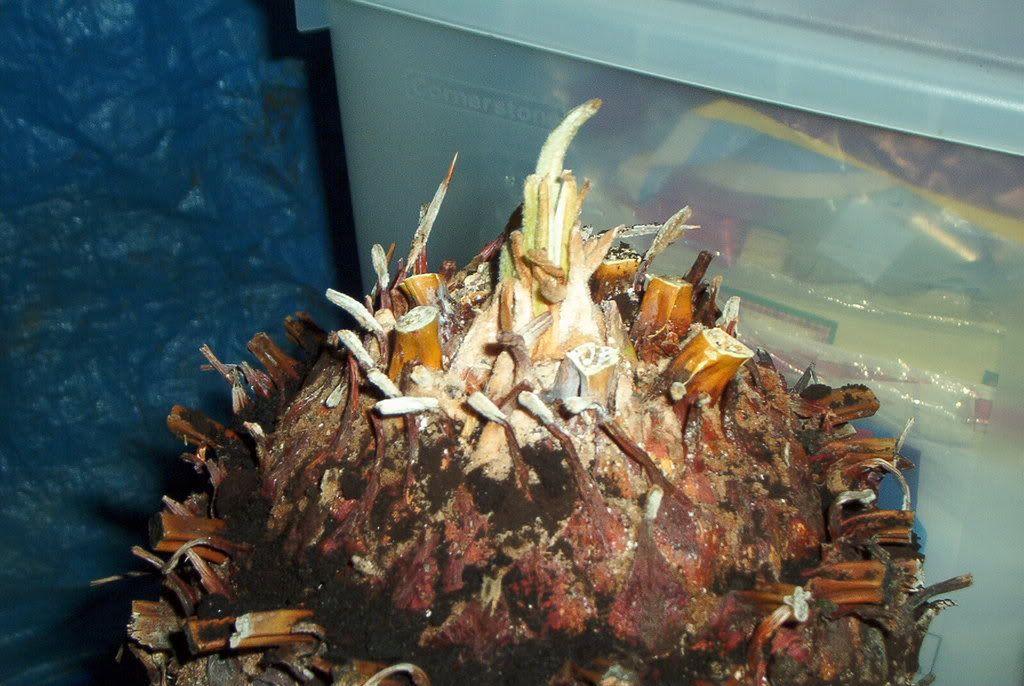
Posted: Sun Feb 24, 2008 5:53 pm
by Knnn
Wes,
I've done plenty of the same things ( especially during the Winter months with things being crowded

As soon as the weather warms a bit, yours will be pushing out new fronds like nothing happened!
Steve
Posted: Sun Feb 24, 2008 10:13 pm
by lucky1
Any guess on age for that Palatka Giant in Jody's pic?
What a shame these coonties aren't retained as urban/rural sprawl continues.
You'd think people would flag valuable specimens so they could remain as mature plants in new landscapes.
Wes, I can sympathize...my Dioon Spinulosum's got a few bends and breaks from my moving it, and as you know they don't ever heal. But that huge caudex will explode with leaves soon.
Steve, wow, really moving along

Presume you've turned the heating off now? versus the previous 80*F?
Barb
Posted: Mon Feb 25, 2008 4:18 am
by virtualpalm
lucky1 wrote:Any guess on age for that Palatka Giant in Jody's pic?
What a shame these coonties aren't retained as urban/rural sprawl continues.
You'd think people would flag valuable specimens so they could remain as mature plants in new landscapes.
I would guess that plant is around 100 years old. The area where these occur is fairly rural, and Palatka itself is a small town. Lots of the large plants have been preserved. In fact, many are seen growing in cemeteries (see below).
Jody

Posted: Mon Feb 25, 2008 4:54 am
by Kansas
Jody, do you have any more pics of Palatka? I just love that part of Florida. I was recently offered a job in Belleview where I would be the supervisor for three counties around there. Not sure if Palatka was one of the towns I would be over, but I LOVE that part of Florida. Sadly, the wife blew a gasket when she found out I even put in for the job so I am not moving

But my ideal living is swamp area with Spanish Moss in every tree. I know the road called "Tunnel of Love" down there is wonderful as I have seen short films on it....
http://www.youtube.com/watch?v=zzcRgTG5y_o
Posted: Mon Feb 25, 2008 8:40 am
by lucky1
Jody, thanks for that super pic
...and what a testimonial for cycads generally as understory plants.
They retain such a clean look.
100 years ...

Cool video. Wish the driver had slowed down so trees could be seen more clearly.
Vancouver BC folks will want to meet-or-beat that video with the world-famous drive through Stanley Park.
Ancient vine maples, growing densely on both sides of the narrow road, meet in the center overhead.
It's magical.
Wes, sounds like it was tough to turn down that job.

Barb
Posted: Mon Feb 25, 2008 8:57 am
by Knnn
Barb,
I have the green house heater set to a 50* - 53*F low, starting to hit the low 80's now with the increased sun light.
Steve
Posted: Mon Feb 25, 2008 9:30 am
by lucky1
The speed at which your plants are growing makes those temps near-perfect.
What's your guess on degree benefit at night from your water-filled containers.
Barb
Posted: Mon Feb 25, 2008 9:58 am
by Knnn
I only have about 300 gallons total, any added heat is probably too short lived to measure.
One benefit of the extra mass is that it does seem to slow temperature swings, and once the GH starts hitting 90* - 100*, things will really start growing

Steve
Posted: Mon Feb 25, 2008 10:17 am
by lucky1
Big temperature swings are definitely not good.
Three hundred gallons in your GH likely keep the floor warmer too.
Is your floor brick, or native soil/sand?
90 - 100 ... time to throw open the doors and bask in the sunshine.
Can't wait!
Barb
Posted: Mon Feb 25, 2008 12:11 pm
by virtualpalm
I have a couple
Encephalartos flushing at the moment. I thought you all might like to see them...
E. whitelockii
 E. villosus
E. villosus (with some
E. laurentianus behind and a blue
E. longifolius to the right)

Jody
Posted: Mon Feb 25, 2008 1:01 pm
by lucky1
Nice, Jody. Is it customary that E.whitlockii is so nice and tall, or perhaps lower light conditions?
I couldn't open the second pic.
Barb
edit: second pic OK now. that is a beauty.
Posted: Mon Feb 25, 2008 1:10 pm
by virtualpalm
lucky1 wrote:Nice, Jody. Is it customary that E.whitlockii is so nice and tall
The leaves of this species are naturally quite upright. However, as the plant ages and flushes more leaves, the older ones begin to move toward a horizontal position. Here is a photo of a juvenile plant in my yard:

Jody
Posted: Mon Feb 25, 2008 1:21 pm
by lucky1
Jody, seems many cycad species share the upright habit.
This is what first attracted me to cycads.
I noticed the shifting to horizontal plane even on my seedling Dioon Spinulosum as it flushed.
The first whorl seemed to move over (makes sense with the increase in caudex diameter).
Oh, man, that is some beautiful yard...nope, that's a botanical garden!!

That's a juvenile ? Makes mine look like a microspecimen.
I hope to see more yard pics, thanks for posting that.
Barb
ps...reminder to self: next life--->Florida.
Posted: Mon Feb 25, 2008 1:23 pm
by lucky1
I just noticed the caudex size on that E.villosus!

Spectacular.
Mine are starting !
Posted: Mon Feb 25, 2008 3:29 pm
by lucky1
All this talk has embarrassed mine into starting up, for which I thank everyone.
Dioon spinulosum (please ignore the weeds and clover!)

Dioon edule

Zamia vasquezii (barely burping...)

Life is good.
Barb

